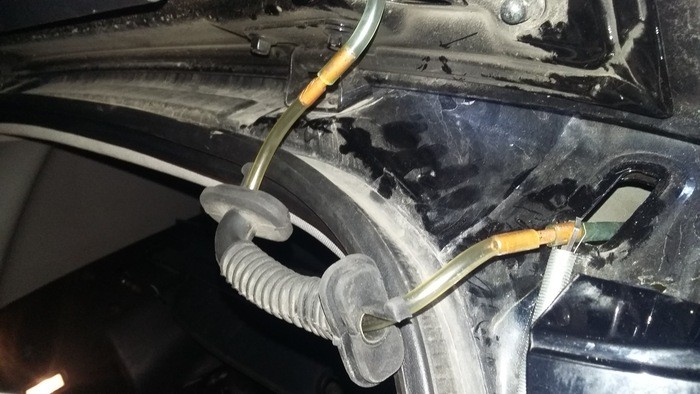
Symptoms of Faulty or Faulty Windshield Washer Tubes
Content
Common signs include missing wiper fluid spray, mold in the lines, and cracked, cut, or melted tubes.
The job of the windshield washer tubes is to transport the washer fluid from the reservoir through the pump to the injectors and eventually to the windshield. Whether you call them tubes or hoses, the part and the work are the same. Typically, washer tubes are clear plastic hoses that, like any other hose, can wear out due to age, exposure to the elements, or extreme heat under the car's hood. If they are damaged, they are often replaced by an ASE certified mechanic.
Most cars, trucks and SUVs sold in the US are equipped with two independent windshield washer tubes that run from the pump to the injectors. They are most often located under sound deadening material attached to the underside of the hood, making them very difficult to see without opening the insulation material. When they wear out or become damaged, they often display several warning signs or symptoms that alert the vehicle owner to replace them as soon as possible to avoid further damage to the windshield washer system.
The following are some of the common signs of a bad or faulty windshield washer tube.
1. Windshield washer fluid does not splatter
The most common signal for a problem with the washer tubes is simply not spraying fluid from the washer nozzles onto the windshield. When the washer tubes are damaged, they leak fluid and are unable to provide a constant flow of fluid to the nozzles. Tubes can be damaged for various reasons.
2. Mold on the lines
Windshield washer fluid contains several ingredients that reduce the chance of mold forming inside the reservoir. Mold thrives in humid and hot environments. Because the windshield washer reservoir is often installed near the car's engine, it collects a lot of heat, making it a Mecca for mold growth. A common mistake car owners make is to use plain water instead of washer fluid to keep the tank full. This causes many problems such as freezing in colder climates (which can cause the tank to crack) but can also accelerate mold growth in the tank, pump, and pipes. If mold grows inside the tubes, it becomes like a hardened artery inside the human body, restricting the flow of fluid to the washer jets.
3. Explosive pipes
Another common side effect of using water instead of washer fluid is that the water inside the pipe freezes during cold weather periods. When this happens, the plastic tubing also freezes and expands, which can break the tubing, causing it to burst when the pump is turned on. If this happens, you may notice water leaking under the car, or when you lift the hood, there will be a wet spot under the protective sheet where the pipe burst.
4. Cut the tubes
In most cases, the washer tubes are protected from cutting, but in many places the tubes are exposed (especially when they go from the pump to the hood). Sometimes during mechanical work, the washer tubes can be accidentally cut or cut, resulting in a slow leak. The most common symptom of this is reduced washer fluid flow to the windshield due to insufficient line pressure.
5. Molten pipes
The washer tubes are connected by clamps that are attached to the hood. Sometimes these clamps break or loosen, especially when the vehicle is constantly driven on gravel roads or in difficult road conditions. When this happens, they may be exposed to heat from the engine. Because the tube is made of plastic, it can easily melt, causing a hole in the tube and leakage.
The best way to avoid most of these problems is to only use washer fluid when the reservoir is full. In this way, the pump will be properly lubricated, the tank will not freeze or crack, and mold will not appear inside the washer tubes. If you notice that your washer fluid is not spraying, it could be due to one of the washer tube problems above. Windshield washer tubes should be replaced as soon as possible by a local ASE certified mechanic to prevent further damage to other windshield washer components.